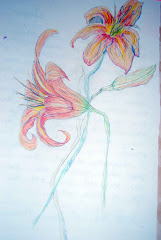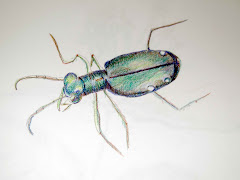

Bounty on the Barren
By Jacqueline Callahan
It was an overcast day and I started out with some unease about the weather; clouds are not helpful for butterfly hunting, but this was my first-ever participation in a National Butterfly count, and despite the dampening effects of the weather, I was excited! I made my way to Camp Saratoga, protected lands owned by the Nature Conservancy, and operated by the Wilton Wildlife Preserve and Park (WWPP), a community-based conservation program in Wilton, near Saratoga Springs, New York. I was meeting Jessica Stager, an intern for the preserve, who was over-seeing the count that day.
I pulled my car into Camp Saratoga, and I found Jessica already there, as well as Michelle Mattocks, an intern with the federal AmeriCorps program. We sat down at a picnic table to go over our methods for the count. Jessica had everything that we would need: several butterfly field guides, some butterfly nets, small plastic bags, a map of the intended exploration area, and the official butterfly count paperwork. She described how we would capture, identify and document whatever butterflies we would see that day. She went over the map that defined the areas that we would cover, and talked about how we would proceed.
As we sat there talking, the clouds began to dissipate, and the sun began to break through. As if on cue, a beautiful Eastern Tiger Swallowtail (Papilio glaucus) fluttered by, and Jessica aptly demonstrated how to capture the lovely specimen.
Approaching the unsuspecting insect with stealth, she scooped the net in a smooth arc, and with precision, the net came down confining the Swallowtail. Deftly, she worked the creature into a plastic bag.
Gently, she held the insect between her index and middle fingers in order to minimize struggle or movement (and resultant loss of scales) explaining as she did this, that if she was ever unsuccessful with this operation, she would be sure to release a butterfly before she would allow it to harm itself in a struggle to escape.
Once inside the bag, we were able to view the insect, and identify it. Though we all knew that this was an Eastern Tiger Swallowtail, we practiced the steps of identification.
First, we turned to the pictorial table of contents in the front of Jim Brock’s Butterflies of North America. Quickly, this table showed that we were dealing with a butterfly that was in the Swallowtail or Parnassians group. Once in the right general vicinity, we were able to identify our captive positively. We then released our prey, unharmed.
Later in the day, when we’d captured a Northern Pearly Eye (Enodia anthedon) and found that it wasn’t as easy to identify (due to its faded and somewhat tattered condition) we found that the maps showing specific butterfly regions, as well as the careful descriptions of species’ characteristics, were very helpful in pinpointing the species.
The clouds continued to persist, and the day was partly sunny at best, so we didn’t see a tremendous variety in our first location, but Jessica and Michelle assured us that if we got into our cars and drove to another near-by locale, we’d be sure to see something very special. Our group (now grown to six) unanimously decided to head over to the other location.
As a leadership volunteer for the WWPP, I knew that we were dealing with a very special area. The region we lived in was located in an ancient lakebed known as Glacial Lake Albany. Twenty thousand years ago, glaciers had carved out this lake basin, and when the glaciers retreated, the lake was created. Local rivers, such as the Mohawk, had flowed into this lake, and deposited large amounts of sand and sediment. Thousands of years later, the lake dried up, exposing the ancient lakebed. Winds then swept the sand into dunes, leaving the unique Oak Pine Savanna (or Pine Barren) with rolling, sandy hills that are seen present day. This unique habitat is home to many wonderful species: 70 kinds of mammals, and 120 species of amphibians, reptiles, and birds.
But the area shelters some very significant species, as well: Frosted Elfin (Callophyrys irus) a butterfly designated by the state of New York as threatened; the Blandings Turtle (Emydoidea blandingii) also designated as a threatened species; the Eastern Hognose Snake (Heterodox platrhinos) state designated species of special concern; the Eastern Spadefoot Toad (Scaphiopus holbrookii) state designated species of special concern; and the Blue Spotted Salamander (Ambystoma laterale) state designated species of special concern.
But the most well known resident of the area, I knew, was the Karner Blue Butterfly (Lycaeides melissa samuelis) listed on both the federal and state levels as endangered. Like its fellow special inhabitants of this unique environment, it too, was in trouble.
Historically, its range once covered an area east to west that reached from Maine to Minnesota, and latitudes between 41 and 46 degrees (south to north.) But (as some estimates claim) 99% of its population has declined in the past one hundred years, with the past ten years having been the most detrimental. While there are still healthy populations in Michigan and Wisconsin, it has been extirpated from Pennsylvania, New Hampshire, Massachusetts, Maine, Ohio, Illinois, Iowa and the Canadian province of Ontario. Compared to the populations in Michigan or Wisconsin, the local population is miniscule.
To make matters worse, the Town of Wilton has recently been listed as the second fastest growing municipality in New York. Habitat was swiftly being lost due to residential, commercial and light industrial development.
In order to do something about the dramatic decline in habitat, and to protect this fragile and threatened area, The Nature Conservancy banded together with New York State Department of Conservation, and the Town of Wilton, as well as Saratoga County, to help save the habitat of these precious species. To date, these organizations have made a unified effort to protect hundreds of acres in order to safeguard existing, and develop new habitat. Thankfully, all of these lands have been acquired from willing sellers.
Wild Blue Lupine (Lupinus perennis) the Karner Blue’s hostplant, thrives in sandy soils and in sunny and open locations. These open areas once occurred naturally due to agriculture and spontaneous fires from lightening strikes. But as farming has dramatically decreased, and spontaneous burns have become increasingly suppressed, the open areas that are crucial to Wild Blue Lupine survival, and therefore the Karner Blue butterfly, have significantly decreased. As a result, WWPP and its partners have worked to restore the natural habitat by planting acres of Wild Blue Lupine, as well enriching the habitat by planting nectar-rich native species such as Butterfly Weed (Asclepias tuberosa) Bush Clover (Lespedeza) New Jersey Tea (Ceanothus americanus) and Horsemint (Monarda punctata).
I knew that we were headed toward one of these restored Karner habitats and my hopes were high that I would see one of these beautiful butterflies that day. I began to suspect that something very special was about to happen when, as we got out of the car, Michelle handed me a hand-held counter in order to keep track of the Karners.
As we crossed over the fence onto the sandy soil, I saw a mass of Wild Blue Lupine, flowerless now, as it was going to seed. As we walked, gingerly, careful to stay to the path, Jessica lightly touched the Lupine plants, and as she did, tiny clouds of Karners fluttered up before our eyes. I was clicking the counter continuously: ten, twenty, twenty-five, thirty, forty, forty five, before we were through, I’d counted ninety-six Karner Blues! Someone said, “How can we be sure you’re not re-counting the same butterflies?” Jessica explained that though we couldn’t be sure that we weren’t recounting some of them, we knew that there were many more that we weren’t seeing, and on average, we could be pretty sure that our number was not terribly exaggerated. Michelle Mattocks, the intern whose job it was to monitor the Karner population, had been getting counts consistent with this day’s number.
I watched, spellbound as these beautiful creatures fluttered about. The male’s upper-side is a lovely silvery blue, while the female’s upper-side is a bluish brown, with orange crescents and dark markings along the margins. The undersides of both sexes have black and orange markings. They are diminutive: only about an inch across.
As the Wild Blue Lupine’s flowers were now spent, they obtained nectar from Spotted Knapweed (Centaurea maculosa) and Common Milkweed (Asclepias syriaca) as well as one or two Butterfly Weed (Asclepias tuberosa) bushes that were present in this locale.
(It is important to note here, that native butterflies require native hostplants, as native plants contribute to the diversity of the habitat. As is commonly known, invasives such as Spotted Knapweed crowd out native plants depleting the diversity of the ecosystyem. This plant is particularly detrimental for the habitat, for its roots secrete a toxin that inhibits the growth of surrounding plants. As a result, WWPP and its volunteers have spent a good deal of time trying to eradicate it from the restored habitat area – no easy feat, as Spotted Knapweed can reproduce at an alarming rate: each plant can produce up to 1,000 seeds!)
The Karners were relatively easy to follow for they are not high fliers, and on this day, were not covering a great deal of territory. (Common belief has held that 200 meters was the maximum of territory covered during the Karner’s lifespan, but recent research has indicated that some of these butterflies may travel as much as 2 or 3 miles.) However, it is known that the entire life cycle of the butterfly is played out amongst the Wild Blue Lupine, with the Karner Blues even laying eggs on the ground near the Lupine once the plant has gone to seed.
I turned slightly to the left, and there before my eyes, a drama played out: a Jumping Spider (Eris marginata) pounced on and began to consume an adult Karner. As I watched mesmerized by the power of nature, and the cycle of life and death, I wondered about the future of this species.
As we got in our cars and drove away, I felt an enormous respect for the many people who have worked so hard to preserve the life of this species, and others, and I had a renewed desire to be a part of that effort.
Here are some ways that you can help:
∑ Support Prescribed Burns in order to Preserve Wild Blue Lupine Habitat: Specifically, Oak Savannas, Pine Barrens and Prairies
∑ Act to Preserve Existing Wild Blue Lupine Habitat
∑ Avoid the use of Chemicals and Pesticides near Wild Blue Lupine and/or Karner Blue butterfly habitat
∑ Create butterfly gardens using native plants
First published July 2004





No comments:
Post a Comment